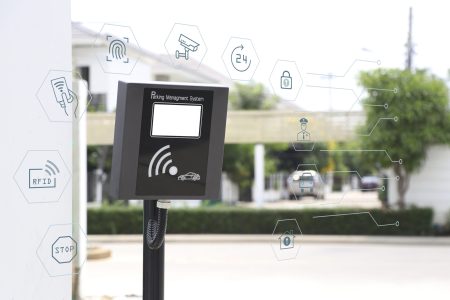What is automatic vehicle identification and how can it help organisations with their security, as well as improving urban safety
When we think of access control, often what comes to mind is a system that restricts access to buildings, rooms and physical IT assets. However, it’s only one aspect of a bigger, layered approach to security management, going beyond controlling people’s access within the building; vehicle access control.
Did you know that automatic vehicle identification can also enable businesses and organisations to control vehicles entering and leaving their premises? And with connected car shipments to rise to over 77 million by 2025, the use of automated vehicle access control is set to increase at a rapid pace.
A robust vehicle access solution will not only increase the security of your premises, but it will also improve your car park efficiency, customer experience, reduce costs and simplify the fleet management, and more.
In most cases, automatic vehicle access control includes the following key components:
- Vehicle detection and identification – inductive loop detectors, long-range readers, ANPR ,etc.
- Physical Barrier to the premises – sliding gates, barriers, bollards etc.
- Access Control Management – controllers, system management software
- Access Control Credentials – pin numbers, ID cards, windscreen tags, window buttons, smartphones, etc.
Together, these components provide a flawless, integrated experience for vehicles entering and exiting the premises. For businesses, this solution improves security, cuts down on needless costs and helps to manage vehicle access in a more efficient and streamlined way.
There are various technologies involved in vehicle access control, such as RFID tags, ANPR, and others. Let’s take a closer look at some of these technologies and how they work.
Automatic vehicle identification using an RFID system
Currently the most popular technology used for automated vehicle identification, the RFID tag market is projected to be sized at around US$24.5 billion in 2022. Radio Frequency Identification (RFID) utilises electromagnetic fields to automatically identify and track various objects.
When it comes to vehicle access solutions, RFID tags are often placed on vehicles like buses, taxis, or employees’ cars to automatically identify them and grant secure access to the premises.
RFID can use various frequencies, however, the most commonly used are low, high and ultra-high frequencies. In most cases, automatic vehicle identification systems utilise ultra-high frequencies, as it offers a higher read range and has a stronger signal. It has been predominantly used in logistics to track and trace parcels and products within the production and distribution processes.
Most RFID systems include a microchip with an antenna (tag), a reader with an antenna and an access control server. There are two different types of tags: passive tag and active tag. A passive RFID tag doesn’t include a battery; therefore, its’ built-in antenna picks up on the electromagnetic waves that are sent out by the reader.
On the other hand, an active RFID tag has its own battery power allowing it to transmit the data stored on to it directly to the reader. While systems like proximity readers or barcode scanners require you to hold the badge or ID card close to the reader, a Long-Range RFID system can be read from farther distances. The read range will depend on the frequency and type of tag.
But how does the reader identify who exactly is entering the premises? When the vehicle approaches the entry/exit station, an RFID system will cross-reference the data stored on the tag with its own database. If it matches, the access is then granted.
RFID vehicle tags
So, now that we identified what RFID technology is and how it is utilised in vehicle access control, it’s important to look at various ways organisations can tag their vehicles. There are four main types of UHF tags that can be used in various environments:
- External tags enable long-range vehicle identification and is a tamper-resistant, transparent adhesive tag, which allows quick and easy installation onto the non-metal exterior parts of the vehicle.
- Windshield tags offer long-range identification of up to 10 metres. Similar to external tags, windshield tags can also come in a tamper-proof version to allow for additional security.
- Heavy duty external tags are perfect for long term use in outdoor and industrial environments. They can also be cable-tied or bolted onto bicycles, forklifts and many other industrial devices.
- Combi-cards combine long-range UHF tag and proximity or smartcard technology. This enables the use of one card for both vehicle and building access applications.
Automatic vehicle identification and ANPR
The most common decision when designing an automated vehicle access system comes to the decision between ANPR vs long-range RFID. ANPR is an accurate system that automatically reads vehicle number plates as they approach, and converts valid number plates into standard Wiegand format ID numbers.
This data is then analysed by the access control system. This solution is perfect for applications like vehicle access control, automatic toll collection, visitors’ management at parking facilities or other situations where it is not desirable to issue RFID tags.
It enables you to provide automated 24-hour access to secure sites or car parks by entering the relevant vehicle’s number plate into the system. When pre-approved vehicles turn up, the barrier will open allowing free-flowing vehicle access in and out of any secure site. Access can equally be removed or revoked at any time.
ANPR systems have been around for several years and can deliver substantial benefits to secure site operators and consumers alike. Its technology was created to help end queuing at barriers and is an ideal standalone solution for busy sites which require secure automated vehicle identification.
Gatehouses and vehicle access control
Security of the building often starts at the gate. Facility’s gatehouse or a barrier is a visitor’s first touch point with the premises. Therefore, it’s essential to ensure that it implements a robust security system, providing the best user experience whilst also securing the premises from unauthorised visitors.
The encroachment of technology into all aspects of car parking is helping businesses to automate their security systems and make them as efficient as possible. The best way to do this is by automating vehicle access control and implementing integrated security solutions that work together to secure the premises on various levels.
When it comes to automating vehicle access at the gates, companies have two options to choose from: RFID powered systems and ANPR.
RFID powered readers are triggered by a tag attached to a vehicle. Depending on the system, long-range RFID readers can identify vehicles at a distance from 5metres to up to 10 metres. In most cases, an RFID system will cross-reference the data stored on the tag with its own database.
If it matches, access is then granted and the reader sends the signal to the gate/barrier, allowing vehicles to enter the premises. ANPR solutions are best utilised on premises where it is not desirable to issue RFID tags. With a read range of 2 to 10 metres, the ANPR camera ensures efficient recognition of vehicles.
Deep learning algorithms make it possible to accurately capture numbers under harsh conditions and read plates with different font formats. If vehicles need to be granted access temporarily or incidentally, the ANPR camera is the best way to go.
People & vehicles: An integrative approach
Apart from tracking entry and exit of a particular vehicle, RFID can also be used to monitor time & attendance and employee or visitors’ location. Therefore, an RFID system can be a great asset, especially when used as a part of a bigger, integrated access control system. Not only can it be used for security and safety purposes, but it’s also a great way to track your employees’ attendance and create comprehensive audit logs.
No doubt, the ability to control access for people both when they are on foot and when they are driving a vehicle, offers great benefits. With the help of a single ID card, organisations can simplify their management, improve security levels and reduce unnecessary costs.
This is a perfect example of different layers of an access control system, where both vehicle and people tracking systems work together in an integrative manner.
If each authorised member of staff or customer is issued with an electronic ID card (proximity card or smart card) to allow them access to secured areas within a building or installation, then the same card can be used to authorise the entry of their vehicle onto the site or into the car park.
In addition, their vehicle can be registered on the vehicle access control system to prevent unauthorised vehicles from entering or leaving the site.
The need for this type of technology is driven not just by the current challenges that we are facing with COVID-19, but also by drivers that are tired of wasting time at the gates and barriers.
The survey conducted by the IPI revealed that 59% of the respondents mentioned the need of “more innovative technologies to improve parking access control and payment automation”, and noted that it is a number one trend that is having the greatest effect on the parking industry. Therefore, when it comes to managing security the key words are going to be automation and ability to think of a bigger picture, rather than addressing vehicle access and people access as two different systems.
Jonas Svensson, CEO, TagMaster
With software for AI (Artificial Intelligence) and deep learning advancing, new cameras now offer solutions for automatic counting of vehicles going in and out of a parking lot, automated access for vehicles that are allowed to enter an area and barrier control, alarm management and ticketing integration and more.
Our CT45 for example uses a Linux based Operating System to ensure a stable and secure platform. It is equipped with Power over Ethernet (PoE +), which means that mains power is not required and that it can be supplied with power via solar cells. Installation and setup of the camera is therefore possible anywhere, creating opportunities of flexible security that wouldn’t otherwise be available.

Vehicle recognition and access control cameras offer functionality such as a dual plate reading option, reading of front and rear plates on the same vehicle and the ability to cover wide lanes. They can also track direction of travel and report entry and exit, using a single camera and in addition data can be retrieved from the camera to be used for analysis purposes.
This means that the market can now offer the best ANPR cameras in solutions for parking, access and security as well as traffic monitoring systems. These are all solutions where it is extremely important to be able to quickly and accurately identify vehicles.
Commentary: Uri Guterman, Head of Product & Marketing for Hanwha Techwin Europe
Hanwha Techwin is continuing to see increased interest in smart city type solutions from local authorities who are looking to update or enhance their existing systems. This is reflected in a product strategy which has seen the introduction of a wide range of Wisenet products and solutions designed for city centre applications and transport applications.
Wisenet X PTZ PLUS cameras, for example, are equipped with AI based auto-tracking and an innovative hand-over feature which moves adjacent cameras to pre-set positions. This enables them to continue to auto-track a target person or vehicle as they move out of the field of view of the first camera.
To help keep traffic moving, Hanwha Techwin and analytics specialist Sprinx Technologies have combined their expertise to introduce the Automatic Incident Detection (AID) solution which detects broken down or illegally stopped vehicles and lets operators instantly know when there are lengthening traffic queues.

Hanwha Techwin has also worked in partnership with analytics experts FF Group to introduce a comprehensive suite of ANPR based intelligent traffic management solutions. These range from car park access control for business applications, through to large scale city wide based systems, which enable local authorities to keep people safe as well as detect illegally parked vehicles and other traffic infringements.
For transport specific applications where there is a need to combat anti-social behaviour, as well as to comply with health & safety regulations, vibration proof Wisenet cameras and small footprint mobile NVRs combine to provide a robust solution for monitoring activity on buses, trains, trucks and other forms of transport.
Vincent Dupart, CEO of STid
There no longer is a need to install multiple readers at entrances where employees, visitors, contractors and their vehicles enter the facility. It can easily be integrated with any access control system or parking management system. Which basically means that any perimeter entrance can now be equipped easily. For example our STid Mobile ID solution and our vehicle identification solution can be integrated. And since it supports both solutions simultaneously, it is now also possible to identify the vehicle, using UHF, and the driver, using STid Mobile ID. This prevents the car from being used as a modern-day Trojan Horse.

Hands-free readers increases speed of entry for anyone – or anything – on two feet, two wheels, four wheels or a whole fleet. It can read windshield tags, key fobs, cards, smartphones, or wearables using UHF and Bluetooth to leverage end-user preferences for easier adoption. It is also part of an ecosystem, which turns smartphones into virtual cards for both vehicle and pedestrian access control.
RFID readers can be compatible with all access control systems worldwide, for easy integration regardless of managers’ tech expertise. Our nano readers has rugged and durable outside packaging to ensure the reader can stand up to harsh environments – everything from shock, heavy rain, and dust, to salt, frost, and fire. SPECTRE nano can also event offer customised branding options to fit in at a bus station, corporate office, or private community, and is able for use in high-security industries. New reader technology in the RFID field can be installed and (almost) forgotten, with no maintenance or batteries required, with the highest of spec. This is the future of transportation and building access control.
To stay up to date on the latest, trends, innovations, people news and company updates within the global security market please register to receive our newsletter here.
Media contact
Rebecca Morpeth Spayne,
Editor, Security Portfolio
Tel: +44 (0) 1622 823 922
Email: editor@securitybuyer.com













